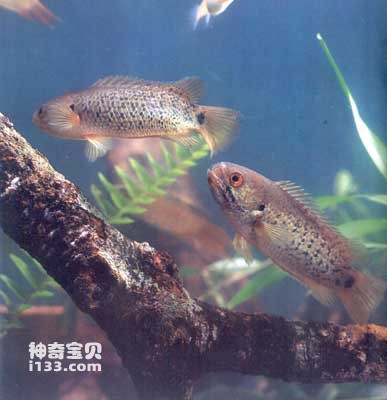Anabas testudineus belongs to the order Perciformes, suborder Anabas, family Anabasidae, and genus Anabas. English name: Climbing perches, Climbing gouramies.
It is so named because it looks like a perch and can climb trees. The body is oval, with flat sides; the head is round and blunt, and the snout is short. The eyes are slightly larger, the orbital bones are covered with skin, and the lower edges are serrated. At the end of the mouth, the cleft is slightly oblique, and the rear end reaches below the middle of the eye. The jaw teeth are small, and the operculum bones have serrations. The serrations on the posterior edges of the operculum bones and hypooperculum bones are spinous. There is a valve-like auxiliary respiratory organ in the epibranchial cavity; the gill cover membrane is healed and is not connected to the isthmus. The head is scaly; the body scales are slightly larger; both the dorsal and anal fins have scale sheaths. The lateral line is broken at the back of the body and becomes an upper and lower line or overlaps. The bases of the dorsal and anal fins are both very long and divided into two parts, with the rays shorter than the spines. The pectoral fins are rounded and blunt, the pelvic fins are moved forward, and the caudal fins are rounded. The body is gray-green, with about 10 black-green horizontal stripes on the side of the body, and the stripes or breaks are spots; there is a black spot on the posterior edge of the gill cover in the recess between the two strong spines; there is also a dark large black spot on the base of the tail fin.

The climbing bass is a small common fish in the subtropics. It likes to live in slow currents or still water covered with aquatic plants in the freshwater areas of river mouths. It often likes to live in mud-bottom ditches and ponds. It can drill into the mud to a depth of more than half a meter during drought. It can swarm in the pond after rain when there is not much water. . Sometimes it climbs to the grass and hangs on the grass with the edge of the orbit, the spines of the gill cover and the spines of the even fins and the front of the anal fin; sometimes it can climb to the palm trees on the shore. It eats animal bait and feeds on zooplankton, shrimps, small fish, etc. With the help of auxiliary respiratory organs, it can survive for several days out of water, and can crawl on land relying on its fins and gill covers.
The reproductive method of climbing bass is mostly by male or female fish building special nests. Some build nests on the water surface made of bubbles wrapped in mucus; some are built with plants in the shape of a bird's nest. There are obvious differences between the sexes. The male fish is larger, has longer fins and has obvious marriage coloration. Marital play occurs between male and female fish during spawning.
Distributed in the tropics and subtropics of South Asia and Southeast Asia. In China, it is found in various water bodies in Yunnan, Guangxi, Guangdong, Hainan Island, Taiwan, Fujian and other provinces and regions south of Nanling.
They are small in size, about 25 centimeters long as an adult, but they are widely distributed and abundant in number. Their meat is tender and delicious, and the masses like to eat it.
animal tags:
We created this article in conjunction with AI technology, then made sure it was fact-checked and edited by a Animals Top editor.